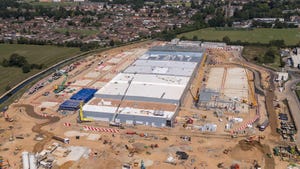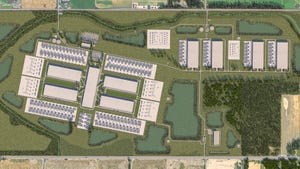
Insight and analysis on the data center space from industry thought leaders.
Edge and Hyperscale Data Centers in the AI Era: Explosive Demand and Important Risks
From hyperscalers to the edge, understanding the differences between the types of data centers supporting AI development is the key to capturing their value.

As companies pour resources into AI, it is important to understand the different types of data centers supporting AI development and their unique features. Data centers are critical pieces of digital infrastructure that provide the computing power for real-time analytics, AI solutions, and global communications. Yet not all data centers are the same – from edge to hyperscale data centers, each must design and plan for necessary energy consumption while balancing sustainability and cost-efficiency. Complications can arise when developers are buying land for new data centers, updating existing data center infrastructure, and navigating state and local government regulations.
Despite these challenges, investors are poised to take advantage. The global hyperscale data center market is expected to grow from $320.59B in 2023 to $1.44T in 2029. The edge data center market alone is projected to expand at a CAGR of nearly 10% each year until 2030. Knowing the differences between types of data centers will be key to capturing that growing value.
What Are Edge and Hyperscale Data Centers?
Edge and hyperscale data centers are distinguished by two main elements: physical proximity to the end-user and physical size of the data center. Edge data centers are located closer to the end-user and are often smaller in size. They can be onsite in an urban office or local warehouse, in cell towers, or in regional centers. Size constraints often mean edge data centers consume less energy because they are equipped with less local processing power. The benefit is that close proximity to the end-user allows for rapid delivery of technology solutions without having to transmit data over long distances; and high bandwidth and low latency are some of the most important drivers of edge data center growth.
At the other end of the spectrum are hyperscale data centers. These are typically built in rural campuses, often for one user (e.g., Google or Microsoft), and pumped with enough energy to power cities. These larger, more distant centers are designed for economies of scale, thereby meeting demand for global computing while driving down costs. Hyperscale data centers are not limited by physical constraints because they are located outside of urban centers and can fit hundreds of thousands of processors in one single location. The computing power of these huge centers is then distributed as needed based on demand.
Practically, both edge and hyperscale data centers come in many shapes and sizes – they can be close to or far away from end-users depending on what is needed in unique marketplaces, and they can be scaled based on data processing volume. Importantly, these different types of data centers work in tandem as an integrated network to deliver computing and communications solutions to hungry consumers.
Data Center Designers Must Adapt to Energy, Economic, and Regulatory Constraints
Data centers need energy to function, but meeting demand for energy requires buy-in from sometimes reluctant local governments. Just one hyperscale data center can use over 1GW of power. In some localities, data centers consume more than 10% of grid capacity, and in Santa Clara, the heart of Silicon Valley, the used grid capacity jumps to 60%. As data centers are installed with powerful new processors, energy consumption is only expected to increase. New graphics microprocessors from Nvidia can draw up to 1KW each, and about the same amount of power is required to cool them. To put that number into perspective, Elon Musk recently installed 100,000 Nvidia processors in a Memphis hyperscale data center to power X’s new AI, with plans to expand to 300,000 processors. When factoring in the energy for liquid cooling, the Memphis data center will require an estimated 600KW, more than 10% of what is needed to power New York City on an average day. (While more attention has been paid recently to energy-related issues, we expect water consumption issues relating to AI and data centers to become increasingly prominent concerns in coming years.)
Energy constraints and regulatory preferences will force data center investors to selectively choose where and how to build edge and hyperscale data centers. Some regulators want to incentivize the development of data centers while other governments, worried about grid capacity challenges and rising energy prices, want to limit that growth. Hyperscale data centers are already being clustered in energy-abundant, low-regulatory regions such as Texas, while Virginia, an established data center hub, is considering legislation that would slow the growth of data center development.
To further address energy concerns, data center engineers are using innovative designs. Hyperscale data centers are being built like self-sustainable mini-cities, with their own electricity generation, battery-storage, and water facilities, to mitigate the risk of government regulation. For example, a proposed 362-acre hyperscale data center in Virginia contemplates using natural-gas powered hydrogen cells to supply the facility.
A strict regulatory environment may also favor more decentralized edge data centers. Edge data centers are often less conspicuous and less regulated because they can range from local AI-powered devices to cell towers or smaller centers and often have decentralized power consumption. They can be co-located in residential and commercial buildings to take advantage of excess energy already flowing to those locations. Ultimately, data center investors and designers must keep in mind energy constraints and local and state government preferences to effectively allocate resources.
Understanding Data Center Types Creates Opportunities for Investors
The demand for edge and hyperscale data centers creates opportunities for investors as competitors fight to supply the computing power needed for AI solutions. Building a network that integrates edge and hyperscale data centers for volume, cost-efficiency, and speed will be a differentiator in the market. The war for talent will reward early consolidations as these complex networks need experienced specialists and engineers to thrive. Similarly, the supporting infrastructure for data centers will grow as edge data centers require upgrades in physical connectivity and as hyperscale data centers require a steady supply of energy from new sources.
Understanding the types of existing data centers and those being designed to meet the huge demand for AI, big data, and cloud computing is essential for avoiding regulatory impediments and energy constraints. Companies will want to reduce the potential for data centers to become energy bottlenecks and instead think ahead to capture large potential growth in the data market.
About the Authors
You May Also Like













